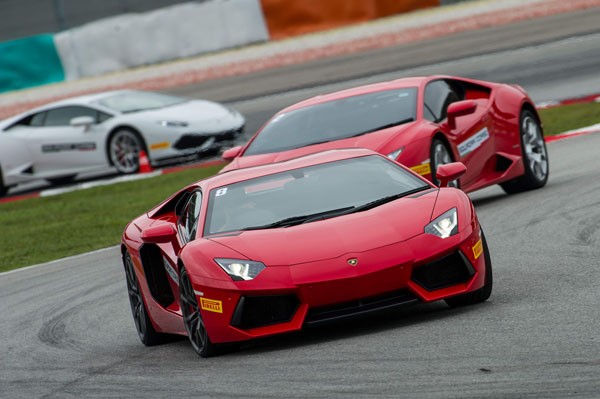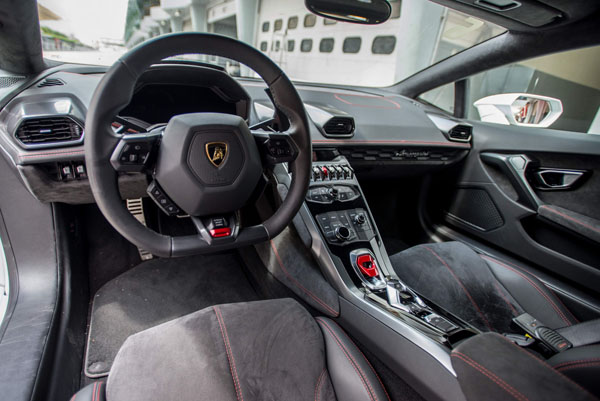The Lamborghini Gallardo was with us for so long we thought it would never leave. Like its Audi sister car, the R8, it just went on and on. Finally, last year, we saw the second clean sheet car from the company that was signed off by the impossibly stylish CEO, Stephan Winkelmann. It’s low, mean, evil-looking and pure Lamborghini.
What happens when you put the Huracan on a track with fast, flowing bends, two seemingly endless straights and a couple of tight hairpin corners? Huracan, meet Sepang, home to Malaysia’s Formula One race and a real test of a car’s abilities.
VALUE
Starting at $428,000, the Huracan is not priced for those who dabble in a few Telstra shares through their internet banking. Lamborghini doesn’t have the cheek to charge extra for metallic paint, so that’s a small mercy.
Apart from the mighty performance, your hard-earned buys you 20-inch alloy wheels shod with exclusive L-for-Lamborghini-stamped Pirelli P-Zero rubber, a six-speaker stereo, climate control, Bluetooth and USB, central locking, full digital dash display, carbon composite ceramic brakes, electric seats and windows, leather everywhere, heated power door mirrors and seriously comfortable, grippy seats.
Predictably, the options list stretches to the horizon but the company will counsel you if you try to do anything considered tasteless. In which case, there are plenty of aftermarket companies that will cheerfully ruin the car for you.
DESIGN
Whereas the Gallardo was all straight-edged and, for a Lambo, sane, the Huracan takes its cues from the rather less restrained Aventador. Flux capacitor LED running lights mark it out on the road and it’s the kind of car whose profile you can sketch in three swoops of the pencil.
The normal doors swing open wide and leave an aperture big enough for even quite rotund owners to climb aboard. The cabin is spacious, especially compared to the very tight Aventador’s, although you’d hardly say that there was a place for everything, because there isn’t. If you want to put your phone somewhere, leave it in your pocket.
The central console is delightfully nutty, with a fighter-jet style switch cover for the stop-starter and rather a lot of Audi-style buttons. These switches are as fit for purpose – and as appropriate – here as they are in the lesser vehicles, so it’s certainly not a complaint. Up above the climate controls is a set of aircraft style toggle switches and above that three auxiliary dials.
The dashboard, though, is a thing of beauty. Highly configurable, you can decide if the central dial is a big speedo or tacho, with the information rearranging itself according to your needs.
The view out front is expansive and uncluttered and out the back you can actually see, courtesy of huge wing mirrors and a larger than expected rear window. A reversing camera is conspicuous by its absence.
SAFETY
Four airbags, ABS, electronic stability and traction controls, brake assist, brake force distribution. An ANCAP star rating is, for obvious reasons, unavailable.
INFOTAINMENT
We didn’t get a chance to try out the stereo, but it does have USB, Bluetooth and an off button to let you enjoy the V10 soundtrack.
ENGINE / TRANSMISSION
The LP610-4 is powered by a 610-horsepower mid-mounted 90-degree V10, driving all four wheels through the doppio-frizione (double clutch) seven-speed transmission.
Six hundred and ten horses equals 449 kW at a spectacular 8250 rpm, with 560 Nm of torque available at 6500 rpm. Acceleration is 0-100 km/h in 3.2 seconds with 200 km/h arriving before the clock strikes ten seconds. With enough road, you’ll hit 325 km/h.
Incredibly (in both senses of the word), Lamborghini claims 12.5 litres per 100 km on the combined fuel cycle test. We shudder to think what it used on the track.
DRIVING
Sepang is situated about 50 km out of the Malaysian capital, Kuala Lumpur. The day we arrived, we were sharing the track with the gentlemen (and lone woman) racers of the Super Trofeo racing series. It was thirty-five degrees and humidity as near as you can get to 100 per cent without being submerged.
The track is a daunting mix of super-long straights and fast flowing corners, with two hairpins and a couple of tight ninety-degree corners to make sure every facet of a car’s performance is tested.
Flip the cover up, hit the button, the V10 roars. Life-sustaining air-conditioning helps to dry the sweaty palms, the wheel-mounted drive select switch is moved to the middle setting – Sport – for the rumble down pit lane. Once past the pit exit, the pedal hits the carpet and we’re unleashed.
The short run into turn one for the first time is taken way too slowly because those carbon-ceramic brakes would stop a Shinkansen dead. Turn the wheel and the nose goes with it, mash the throttle and the electronics let you kick the tail out a bit and give you just enough rope to land on your feet. If you fail to react appropriately, it will do its best to catch it for you.
Through the S and into the first straight and the furious, relentless acceleration of the Huracan pins you to your seat. The double-clutch gearbox bangs the seven gears home. Hit the brakes again and feel the confidence of a pedal that has just the right pressure. Earlier carbon brakes had no feel, but these are up there with the best steel brakes with incredible stopping power.
Again, on the throttle and your ribs are crushed by the way the Huracan hurls itself at the horizon.
Lap after lap, we got faster and faster, the brakes never let us down, the engine didn’t miss a beat, the air-conditioning didn’t falter. Everything we asked the Huracan to do, it did. Corsa mode makes you a hero, tightening up the Huracan’s operating envelope, damping slides and wriggles to ensure that if you find the fastest line, you’ll get the fastest time.
Switch back to sport and the hilarity of sideways action returns. The only time you’ll ever know it was all-wheel drive – apart from full bore standing starts – is in the long, long right-hander. Too fast and the front tyres protested, push the throttle and it felt like it would push wide – understeer at 170 km/h is far more preferable to oversteer for most of us – but keep your foot in, and give it a bit more lock and you will stay on line, all the while your insides will try and escape such is the grip.
The speed, the lateral G-force, the fun of driving an Huracan fast is insanely addictive and breathtakingly easy. The car wills you to go fast, the advanced electronics of the company’s Intertia Platform (a doctoral thesis subject) delivers a base with which it is laughably easy for mere mortals to go incredibly fast.
A track like this is the place to do it. It’s difficult to comprehend a better car to do it in, at least not without spending millions on a McLaren P1.
SUMMING UP 5/5
It was never going to be anything but surreally brilliant. The Huracan blew us away with its usability and forgiving nature, its intense acceleration and braking. It has limits you can find without scaring – or killing – yourself, leaving you to enjoy the feeling of a monstrously gifted chassis and a red-blooded V10.
The Huracan is keyed in to the DNA of Lamborghini – lots of cubic inches, lots of cylinders delivering an emotional, overloading experience. It’s different to that other supersports car maker down the road and for that we should be grateful. Supercars could all converge on one way of doing things and that would be insanely dull. Both CEO Winkelmann and development drier Maurizio Reggiani are adamant – until the rules say stop, naturally-aspirated V10s and V12s are here to stay.
The Huracan is what its name suggests – fast moving, brutal and awe-inspiring.














